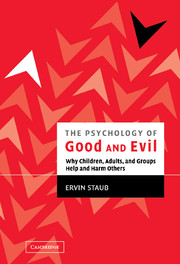Book contents
- Frontmatter
- Contents
- Preface
- Acknowledgments
- PART I INTRODUCTION AND CORE CONCEPTS
- PART II THE ROOTS OF HELPING OTHER PEOPLE IN NEED IN CONTRAST TO PASSIVITY
- 6 Helping a Distressed Person: Social, Personality, and Stimulus Determinants
- 7 Spontaneous (or Impulsive) Helping
- 8 Social and Prosocial Behavior: Personal and Situational Influences and Their Interactions
- 9 The Power to Help Others: Report on a Psychology Today Survey on Values, Helping, and Well-Being
- PART III HOW CHILDREN BECOME CARING AND HELPFUL RATHER THAN HOSTILE AND AGGRESSIVE
- PART IV THE ORIGINS OF GENOCIDE, MASS KILLING, AND OTHER COLLECTIVE VIOLENCE
- PART V THE AFTERMATH OF MASS VIOLENCE: TRAUMA, HEALING, PREVENTION, AND RECONCILIATION
- PART VI CREATING CARING, MORALLY INCLUSIVE, PEACEFUL SOCIETIES
- Appendix: What Are Your Values and Goals?
- Index
- References
8 - Social and Prosocial Behavior: Personal and Situational Influences and Their Interactions
Published online by Cambridge University Press: 07 May 2010
- Frontmatter
- Contents
- Preface
- Acknowledgments
- PART I INTRODUCTION AND CORE CONCEPTS
- PART II THE ROOTS OF HELPING OTHER PEOPLE IN NEED IN CONTRAST TO PASSIVITY
- 6 Helping a Distressed Person: Social, Personality, and Stimulus Determinants
- 7 Spontaneous (or Impulsive) Helping
- 8 Social and Prosocial Behavior: Personal and Situational Influences and Their Interactions
- 9 The Power to Help Others: Report on a Psychology Today Survey on Values, Helping, and Well-Being
- PART III HOW CHILDREN BECOME CARING AND HELPFUL RATHER THAN HOSTILE AND AGGRESSIVE
- PART IV THE ORIGINS OF GENOCIDE, MASS KILLING, AND OTHER COLLECTIVE VIOLENCE
- PART V THE AFTERMATH OF MASS VIOLENCE: TRAUMA, HEALING, PREVENTION, AND RECONCILIATION
- PART VI CREATING CARING, MORALLY INCLUSIVE, PEACEFUL SOCIETIES
- Appendix: What Are Your Values and Goals?
- Index
- References
Summary
As I crossed Harvard Square one day, I noticed a young woman waving her arms and shouting in the middle of the street. She was standing in front of a car, demanding that the driver run her over. Just before I reached her, a policeman appeared and escorted her to the sidewalk. She sobbed, said that she did not want to live, that life is miserable. A local professor-type tried to take her into the restaurant that we happened to be standing in front of, offering her a cup of coffee, presumably wanting to give her a chance to calm down. I was trying to talk to the policeman – who began to disentangle himself from this scene, busily giving information to a driver who stopped near us – telling him that we need to take some action, that the woman needs psychiatric attention. The woman suddenly turned, walked away and disappeared around the bend of the street. An older man and I started to walk after her. Not wanting to seem to chase her, we did not run; and by the time we turned the bend, she was nowhere to be seen. I looked into a couple of stores and a restaurant further down the street, but could not see her.
What happened to this young woman that led to her actions? How would other people, with different personal characteristics, have reacted to the same experiences?
- Type
- Chapter
- Information
- The Psychology of Good and EvilWhy Children, Adults, and Groups Help and Harm Others, pp. 103 - 144Publisher: Cambridge University PressPrint publication year: 2003
References
- 1
- Cited by

